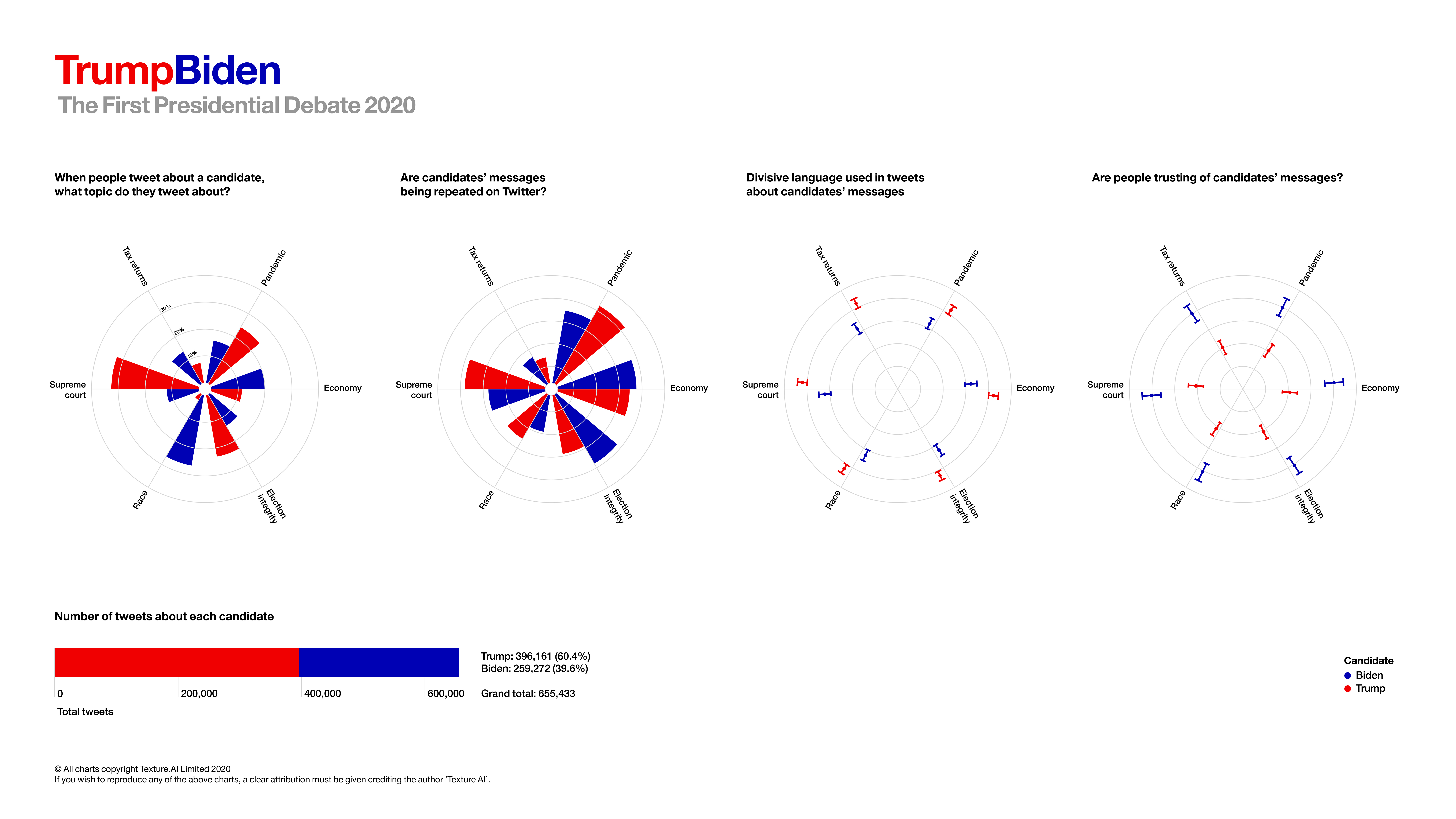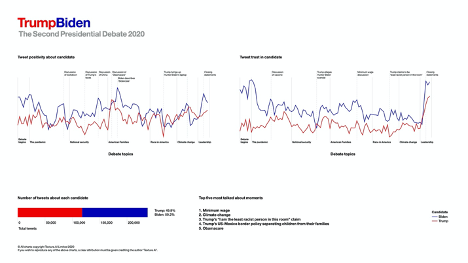The 2020 US presidential election in 280 characters

With the US presidential debates now drawn to a close, Dr James Carney, founder of AI-powered intelligence company Texture.AI, reveals how they have played out over Twitter
Reading the intentions of voters in advance of an election has become a fraught business. Where polls once gave relatively reliable indications of public sentiment, their failure to predict the scale of the Conservative win in 2015, the election of Donald Trump, and the outcome of the Brexit referendum has challenged their credibility.
While there is probably no single reason why polls get outcomes wrong, one factor does keep emerging: the samples used by pollsters often do not reflect the true makeup of the electorate.
The question is, can we use technology to do better? Public social media platforms like Twitter offer a useful lens through which we can view public intentions. No doubt, Twitter has its own sample biases: users skew young and urban, so certain segments of opinion are underrepresented.
However, Twitter compensates by way of scale and speed. Traditional methods of data acquisition use panels numbered in thousands of participants who are polled at intervals of weeks; Twitter gives access to millions of users whose opinions are published every second.
Texture AI used the occasion of the 2020 US presidential election to assess the value of Twitter in tracking public attitudes to candidates. Our aim was to explore the different ways in which methods from AI and the psychology of language can be used to read voter attitudes. We used several measures to extract the patterns behind the data:
● Tweet counts: Candidates mentioned in large numbers of tweets are not necessarily liked — but there is no disputing that they occupy the public imagination. We counted the number of tweets about each candidate.
● Echo scores: By constructing a mathematical representation of a candidate’s message, we are able to measure the extent to which a tweet echoes that message. This allows us to see which candidate is doing most to shape conversations on Twitter.
● Positivity: A tweet can describe a candidate in a negative way or in a positive way, with positive tweets clearly indicating support. Using Texture’s proprietary database of emotional ratings for words in English, we scored candidate-mentioning tweets for positivity.
● Trust: Of all emotions, trust is one of the most important when it comes to politics. Trust Hunter is a Texture AI product that uses deep learning to identify when a message displays trust; we used it here to measure levels of trust in each candidate.
WATCH: President Trump and Joe Biden answer the final debate question. https://t.co/wvxIFOSPIG #PresidentialDebate2020 pic.twitter.com/nLSRSHHlLj
— NBC 7 San Diego (@nbcsandiego) October 23, 2020
The first presidential debate
The first US presidential debate was one of the most chaotic in American history, but which candidate’s message landed best with Twitter users?
An analysis of over half a million tweets about the debate showed that incumbent Donald Trump outperformed rival Joe Biden in shaping opinion on Twitter – but Biden was more positively regarded and more trusted on all issues except the economy (Fig. 1).
The message we took from our analysis of the first debate was that Trump was capturing public attention, while Biden was capturing public regard. In the 2016 election, this strategy worked: Trump’s brash campaigning style energised his base and took the prize from Hilary Clinton.
But 2020 is not 2016, and it’s questionable whether such tactics are a match for Joe Biden’s more inclusive, hopeful message.

Figure 1: Summary results for the first presidential debate
Trump’s Covid-19 diagnosis
If the president’s diagnosis with Covid-19 was unexpected, it presented a good example of the kinds of unanticipated events that can impact on election dynamics. We took the opportunity to investigate whether the sympathy expressed towards President Trump after his diagnosis had any lasting impact.
Results tell a clear story (Fig 2). Following low scores during the debate, language about the president became markedly more positive upon his Covid diagnosis. This peaked the day after his admission into hospital and remained relatively high for the duration of the stay.
However, positivity dropped sharply when Trump’s attitude about beating the virus began to show. This began when Trump visited supporters outside the hospital and got worse the more he downplayed the severity of the virus after his discharge.

The second presidential debate
Our analysis of the second debate tracked how trust and positivity in each candidate changed as the debate progressed. The debate itself focused on 6 topics: the handling of the Covid-19 pandemic, national security, American families, race in America, climate change, and leadership.
By analysing trust and positivity, the algorithm showed how people responded in real time to each candidate’s handling of these topics. We analysed nearly a quarter of a million tweets harvested during the debate.
The results were unequivocal: on all topics, Joe Biden was trusted more and attracted more positive tweets than Donald Trump (Fig. 3).
Biden scored particularly well on healthcare, with the mention of ‘Bidencare’ being particularly popular on Twitter. The only negative for the Democratic candidate was the small dip in trust when Trump mentioned the Hunter Biden scandal.

Conclusion
By aggregating hundreds of thousands of responses as they occur, Twitter gives real-time responses that can be used to infer voter intentions. But what of the election?
Joe Biden’s lead seems to be holding steady. Lagging in the polls after the first debate, Trump needed a clear win in the final debate, and it is not what he got.
Of course, he has a highly energized base which may not be visible on Twitter — and this base upended pollsters’ predictions in 2016. Will they do the same in 2020? Twitter data suggests this is unlikely, but we won’t know for sure until the ballots are counted.




